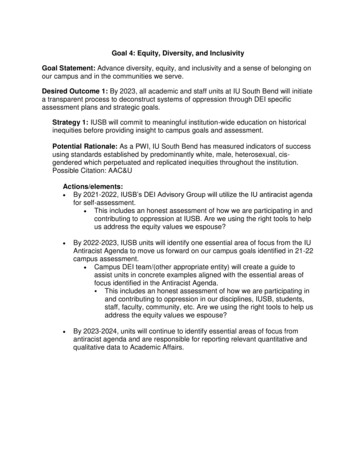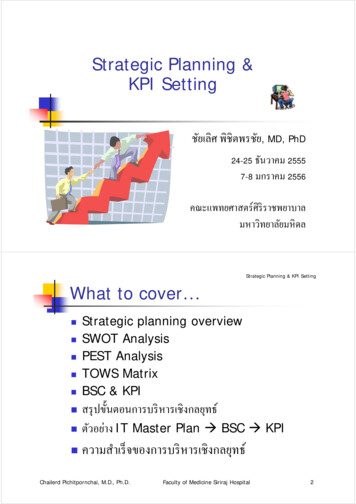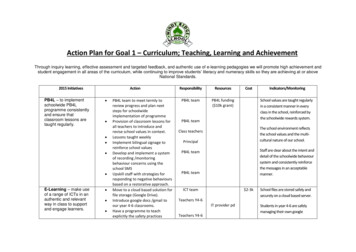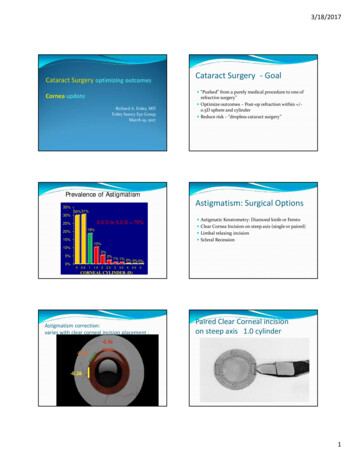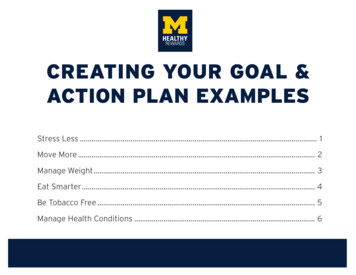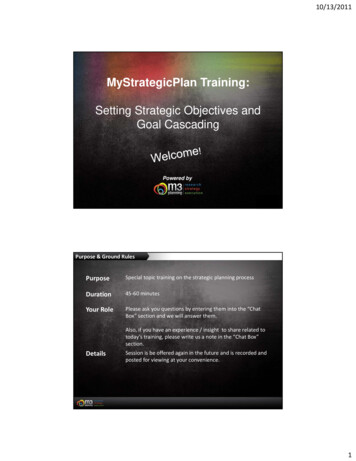
Transcription
10/13/2011MyStrategicPlan Training:Setting Strategic Objectives andGoal CascadingPowered byPurpose & Ground RulesPurposeSpecial topic training on the strategic planning processDuration45‐60 minutesYour RolePlease ask you questions by entering them into the “ChatBox” section and we will answer them.Also, if you have an experience / insight to share related totoday’s training, please write us a note in the “Chat Box”section.DetailsSession is be offered again in the future and is recorded andposted for viewing at your convenience.1
10/13/2011About UsIn the past three years we have Managed 100 strategic planning processesDeployed 800 strategic management systems(MyStrategicPlan, MyNonprofitPlan, MyChurchPlan)Built consensus and commitment with 3,000 executives,managers, boardsEmpowered 1 million strategists & soon‐to‐be strategistsAgendaI.Setting Strategic Objectives: What is a strategic objective?How do they fit into my organization’s strategic plan?II. Goal Cascading: Goal cascading is part of drivingaccountability from strategy to daily action. What are the tipsto doing it correctly?III. SMART Goals: How do you write goals that will drive actionand produce results?IV. Measures and Targets that MatterV. Tap into the Wisdom of the Crowd: Your experiences,insights and questions (Time Permitting)2
10/13/2011What is a strategic objective? How do they fit intomy organization’s strategic plan?SETTING STRATEGIC OBJECTIVESStrategic ObjectivesStrategic Objectives are long‐term, broad categories,non‐measurable, continuous.Objectives answer the questions:In what areas will we continue being actively involved infor the next 5 years?What areas do we need to be involved in to reach ourvision?What areas do we need to be involved in to accomplish ourmission?3
10/13/2011Strategy FundamentalsWhat organizations need to be strategic FinancialRevenue and ExpensesCustomerAcquire, Retain, ServiceInternal ProcessesOperations, IT, Marketing, Sales, PR, Financial, InnovationPeople & LearningHire, Retain, Train, CultureStrategy FundamentalsFour strategic questions1.2.3.4.What are our shareholders or stakeholders expectations forour financial performance or social outcomes?To reach our outcomes, what value must we provide to ourcustomers? What is our value proposition?To provide value, what process must we excel at to deliverour products and services?To drive our processes, what skills, capabilities andorganizational structure must we have?4
10/13/2011Financial rexpectationssocialoutcomes?outcomes?socialRevenue Generation:Revenue Generation:¾IncreaseIncreasesales oror%2011,2012,2013.salesbyby %in erecurringrevenue revenuemixmajorityof ofproductsalesto ctsalesservicesales.Capitalizationofbusiness¾ Capitalization of businessProfitability:Profitability:expenses at %.¾MaintainMaintain expenses at %.Maintain margins at %.¾ Maintain margins at %.Market Growth PerspectiveTo reach our outcomes, what value must weprovide to our customers? What is our valueproposition?Current Customer Management:¾ Increase loyalty, customer satisfaction, referral volume¾ Improve customer service by ¾ Get closer to our customer’s needs by New Customer Acquisition:¾ Market penetration¾ Market development¾ Product/service developmentInnovation/diversification5
10/13/2011Process Excellence PerspectiveTo provide value, what process must we excelat to deliver our products and services?Vendor/Supply Chain Management:¾ Increase number of preferred suppliers¾ Diversify our production facilities¾ Improver our relationships with preferred vendors by Operations Management and Technology Management:¾ Process improvement goals¾ Systems goalsMarketing and Sales Management:¾ Improve or institute a sales process, increase close rate, increase leadgeneration¾ Improve brand management through consistent use of People Excellence PerspectiveTo drive our processes, what skills, capabilities andorganizational structure must we have?Human Relationship Management:¾ Hire and onboarding processes¾ Retention processes¾ Skills and capabilities¾ The right organizational structureKnowledge Management:¾ Structured training (sales, IT, management, ownership)¾ Knowledge transferCulture:¾ Accountability¾ Ownership attitude¾ Living our values6
10/13/2011Goal cascading is part of driving accountability fromstrategy to daily action. What are the tips to doing itcorrectly?CASCADING GOALSStrategy FormulationStrategic Plan FrameworkVisionWhere?Mission, ValuesWhy?Long‐Term StrategicObjectivesAnnual Organization‐wide Goals(Measures, Targets)Department GoalsIndividual Goals/ActionsWhat?What?How?How?7
10/13/2011Strategy FormulationCascading Goals to Departments and TeamMembersNumberLevelWho is responsibleTime Frame1Long‐Term StrategicObjectiveNot assigned – far reaching and verybroad3‐5 years1.1Organizational GoalOrganization‐wide – not assigned18‐24 months1.1.1Department GoalAssigned to Department responsiblefor seeing this goal completed.12‐18 months1.1.1.1Team Member GoalAssigned to Team Memberresponsible for seeing this goalcompleted.6‐12 months1.1.1.1.1Team Member ActionAssigned to Team Memberresponsible for seeing this actioncompleted. Short term items only.30, 60, 90 daysStrategy FormulationCascading Goals to Departments and TeamMembersExample of cascading goals:1 Increase new customer base. (Strategic Objective)1.1 Reach a 15% annual increase in new customers. (Due annually for 2 years) (Organization‐wide Goal)1.1.1 Implement marketing campaign to draw in new markets. (due in 12 months) (DeptGoal)1.1.1.1 Research the opportunities in new markets that we could expand into. (TeamMember Goal) (due in 6 months)1.1.1.1.1 Complete a competitive analysis study of our current and prospectivemarkets. (due in 60 days) (Team Member Action )1.1.1.2 Develop campaign material for new markets. (due in 10 months)1.1.1.2.1 Research marketing methods best for reaching the new markets.(due in 8 months)8
10/13/2011How do you write goals that will drive action andproduce results?SMART GOALSSMART GoalsThink S.M.A.R.T. when you create yourGoals Provide direction, clarity and momentum toachieving a vision Communicate the outcome (Why) Be clear about ownership/accountability Clear and simple To (action verb) (single key result) by (targetdate) requiring (resources).Goals are dreams withdeadlines.-Diana Scharf Hunt9
10/13/2011SMART GoalsSpecific Provide a description of what needsto be accomplished Needs to be understood by everyone Addresses the following:– Who will be involved– What will be accomplished– Where will it get done– When is it to be doneSMART GoalsMeasureable Stated in quantifiable terms, orotherwise they’re only goodintentions Measurable goals ‐facilitatemanagement planning,implementation, and control Provide a clear understanding whenthe goal has been reached– How much? How many?10
10/13/2011SMART GoalsAttainable Provide a stretch that inspires people to aim higher.Goals must be realistic andachievable, or they’re a set‐up forfailureSet goals that you know canrealistically be reached‐but not easyMust have the right resourcesassigned to it to accomplish itShould allow for some flexibilitySMART GoalsResponsible Goals must be assigned to aperson or a department. Department / Person assigned toa goal are not solely responsiblefor its achievement, they are theones held accountable formaking sure it is completed Responsible person isaccountable and equipped foraccomplishing the goal11
10/13/2011SMART GoalsTime-Bound Must include a timeline of whenyour goals should be accomplished Start and end point Intermediate points if it is a longterm goal Limit time, but reasonableSMART GoalsSo what’s the difference between a“SMART” goal and an “UnSMART” goal? Un‐SMART Goal:We want to make more sprockets. SMART Goal:The sprocket department will raise sprocket productionby 20% by the end of this year.If a man knows not what harbor heseeks, any wind is the right wind.12
10/13/2011SMART GoalsIn Business, goal settingthat is S.M.A.R.T. canmake a huge difference inmaintaining growth andmomentum. Whether yourun a modest departmentor a massive corporation,make sure that youalways make an effort toadd these properties tothe goals you set!MEASURES AND TARGETS THATMATTER13
10/13/2011MeasurementsMoving from Outputs to Outcomes What is the result or outcome of achieving thegoal? Why are we working on this goal? How will we know we have accomplished thegoal? What do we expect to see different as a result ofaccomplishing this activity/project?MeasurementsGood Performance Measures: Provide a way to see if our strategy is working Focus employees', managers’ and board’s attention on what matters most to successProvide for employee development so as to empower the teamShould provide common and understandable language forcommunicating to othersAre valid and realistic, to ensure measurement of the rightthingsAre verifiable, to ensure accurate data14
10/13/2011MeasurementsTypes of Measures Efficiency Measures ‐ Productivity and cost effectivenessmeasured as ratio of outputs per inputs(turnaround time per application processed; # of students graduating to number of studentsenrolled) Outcomes Measures ‐ End result of whether services meetproposed targets/standards, and demonstrate impact and benefitof activities(% increase in Internships; Application to Enrolled Yield Rate) Quality Measures – Measure effectiveness of expectations andgenerally show improvement in accuracy, reliability, courtesy,competence, responsiveness, compliance(# audits with no findings or within a range of accuracy) Project Measures – Progress against an initiative that has aterminus. Usual % complete.MeasurementsDeveloping your Performance Measures Identify the right measures Establish increments that mesh with the targets Identify the data source Identify the frequency15
10/13/2011Performance MeasuresDeveloping your Performance MeasuresIncrease number of new customers.Or:Reach a 15% annual increase in new customers by end of year2012.Measure: % increase in new customersTarget: 15%End Date: 12/31/2012ServicesGet Expertise When You Need ItOne-on-one guidance for those trouble spots in your �consulting16
10/13/2011Upcoming TrainingsStrategic Planning 101Oct 19th 12 p.m. P.T.Strategy Huddle Oct 26th 9 a.m. P.T.Execution, Execution, ExecutionOct 27th 12 p.m. P.T.Setting Strategic Objectives and Cascading GoalsNov 9th 9 a.m. P.T.Wisdom of the CrowdAny insights you would like to share related to one oftoday’s topics?Any questions about what we covered today?17
10/13/2011Contact InformationMyStrategicPlan465 Court StreetReno, Nevada 89501(775) 747‐7407 phadmin@mystrategicplan.comOur office hours are Mon‐Fri 9am‐5pm (PT).18
10/13/2011 1 MyStrategicPlan Training: Setting Strategic Objectives and Goal Cascading Powered by Purpose & Ground Rules Purpose Special topic training on thestrategic planning process Duration 45‐60 minutes Your Role Please ask you questions by entering
